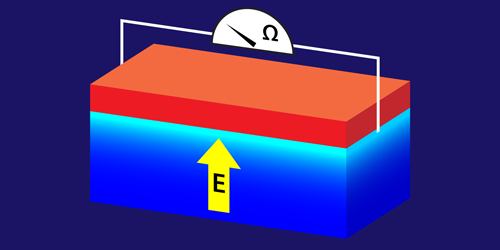A Ferroelectric on the Edge
The material strontium titanate, or STO for short, is a jack-of-all-trades: depending on how it is doped, it behaves as an insulator, a metal, a superconductor, or a ferroelectric. Moreover, when undoped (insulating) STO is layered with other materials, it can host a thin conductive interface, called a two-dimensional electron gas (2DEG). Julien Bréhin, from the French National Center for Scientific Research (CNRS) in Paris, and his colleagues have now induced a 2DEG using a ferroelectric form of STO. Surprisingly, the thin conductor exhibits a kind of ferroelectric memory effect in the way that it switches between two different resistance states.
As previous work has shown, doping STO with small amounts of calcium can transform it into a ferroelectric, which is a material that can retain a permanent electric polarization—like the permanent magnetization in a ferromagnet. Earlier research also demonstrated that depositing aluminum on pure STO can induce a 2DEG at the interface between the two materials.
For their experiment, Bréhin and colleagues combined both techniques, depositing an aluminum layer on top of calcium-doped STO. When they applied a variable electric field to the system, they witnessed the 2DEG at the interface cycling between two states—one with high resistance, the other with low resistance. Like in ferroelectrics, it was the electric-field history that determined which state the 2DEG occupied. This memory effect is a signature of electrical polarization in the 2DEG, which seems impossible given that free electrons in the two-dimensional conductor should move around and cancel any internal polarization. The team says that further study is needed to understand how polarization may be occurring in this two-dimensional system.
This research is published in Physical Review Materials.
–Michael Schirber
Michael Schirber is a Corresponding Editor for Physics based in Lyon, France.




